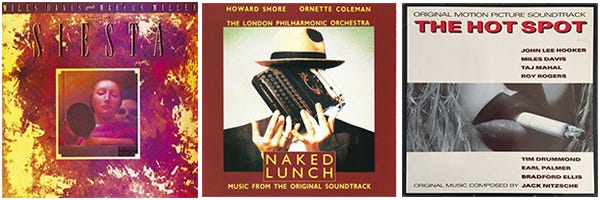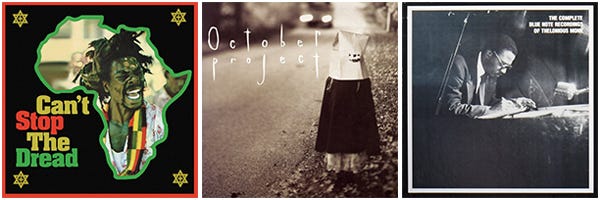New on Shfl, August 2025
Phil Freeman on Organ Jazz, Rick Anderson on Traditional Irish Music, Ned Raggett on 1990s Welsh Indie/Alternative, Chris Catchpole on Rock Progressivo Italiano, plus 15 new recommendations
Phil Freeman on Organ Jazz
From the late 1950s to the end of the ’60s, groups featuring organ, drums, and either electric guitar or tenor saxophone were among the most popular in jazz. Clubs in black neighborhoods could always pack the house with an organ trio, and artists like Smith, Jimmy McGriff, “Brother” Jack McDuff, Richard “Groove” Holmes, Big John Patton and others played funky, soulful, hard-jamming music that also made the careers of guitarists like Kenny Burrell, Grant Green and George Benson.
Collections
Rick Anderson on Traditional Irish Music
Ireland’s folk music has inspired fascination around the world for over 200 years – in the 18th century it influenced classical composers in Europe and the British Isles, and its traces can be heard in both English and American folk music and folk rock to this day, and even in country and gospel music.
Ned Raggett on 1990s Welsh Indie/Alternative
Whether being notably experimental, engagingly poppy or aiming for the arena heights – or all three and more – there’s little doubt that a lot was going on at the time. If sometimes collectively described and perhaps stereotyped as a response to the overweening impact of ‘Cool Britannia’ as such by the mid-1990s – the phrase ‘Cool Cymru,’ referring to the Welsh name for the country, is sometimes used – the sense remains that most of these acts, many with shared roots or growing out of earlier incarnations of other acts, absolutely had something distinct happening.
Chris Catchpole on Rock Progressivo Italiano
The battle lines drawn by punk can still put many off dipping a toe into the world of 1970s progressive rock. However, if you can shake images of Rick Wakeman’s King Arthur On Ice or Peter Gabriel dressed as toad-like creature The Slipperman from your mind, then Italy’s prog scene in the ‘70s – Rock Progressivo Italiano, or RPI for short – offers a cornucopia of wonderful albums worth exploring, even for those who might not know their Gentle Giant from their Genesis.
Reviews
Phil Freeman
Marcus Miller & Miles Davis — Music from Siesta
In 1986, Miles Davis shocked the music industry twice — first by leaving his label of 30 years, Columbia, for Warner Bros., and then with Tutu, a cybernetic, digitally flash-frozen album of collaborations with bassist/producer Marcus Miller that earned him a Grammy. One year later, the pair went back into the studio to score the arty drama Siesta, and once again the results were modern and brilliant, but this time they also looked back decades, to the trumpeter’s greatest orchestral album, 1960’s Sketches of Spain.
Howard Shore & Ornette Coleman — Naked Lunch
Composer Howard Shore found the perfect partner to score the movie: alto saxophonist Ornette Coleman, whose late 1950s recordings helped break open jazz, creating new avenues for instrumental expression just as Burroughs had cracked through the façade of 1950s social conformity with his horrific, junk-poisoned satire. (Naked Lunch was first published in July 1959; Coleman’s breakthrough album, The Shape of Jazz to Come, was released in November of that year.)
Jack Nitzsche — The Hot Spot
The 1990 movie The Hot Spot, directed by Dennis Hopper and based on a 1953 novel called Hell Hath No Fury, was the sweatiest noir since 1982’s Body Heat. It’s a coiled, twisting tale of robbery, blackmail, adultery and (maybe) murder, but the best thing about it is its soundtrack.
Rick Anderson
Thelonious Monk — The Complete Blue Note Recordings
As we all know, “important” recordings are not necessarily more enjoyable because of their importance. But this collection of sessions recorded by Thelonious Monk for the Blue Note label between 1947 and 1952 is truly a treasure in just about every way.
Can't Stop the Dread (High Note Roots 1975-1979)
The High Note label, owned and operated by producer Sonia Pottinger (a rarity in the almost entirely male reggae music scene), released a prodigious stream of singles throughout the 1960s and 1970s in a variety of styles, but the best songs were always those in a roots-and-culture style – sufferer’s anthems, songs of political protest, and Rastafarian doctrinal disquisitions by artists both famous (Justin Hinds, Delroy Wilson, Leroy Smart) and obscure (Aston Whittaker, The Survivors).
October Project — October Project
You want to call them pretentious, and I’ll say okay: the fruity contralto voice of lead singer Mary Fahl, the literary flourishes of Julie Flanders’ lyrics, the orchestral tendencies of the arrangements… yes, arguably it’s all a bit much. But Fahl wields that unusual voice with great taste, the melodies are consistently genuinely catchy, and the arrangements never get completely away with themselves.
Ned Raggett
Ganser — Animal Hospital
Having established themselves in the late 2010s with some excellent releases, Chicago’s Ganser went through lineup changes and other fits and starts before returning with a new full album in 2025, Animal Hospital, centered around the continuing rhythm section of Alicia Gaines and Brian Cundiff as well as new lead vocalist Sophie Sputnik. (Former member Charlie Landsman and Dove Hollis fill out things on guitar.)
Marissa Nadler — New Radiations
The continuing excellence of Marissa Nadler’s work exploring the possibilities of what singing and acoustic guitar can do are demonstrated once more on 2025’s New Radiations, her tenth official full length release over the years. Aside from engineering by Randall Dunn and extra performances from Milky Burgess, it’s all Nadler throughout, from the layering of vocals to the additional instrumentation that shapes the often haunted, sometimes queasy flow of the eleven songs featured.
Lida Husik — The Voyage Out
2025’s The Voyage Out was the first new album from the still underrated Lida Husik in seven years, and only her second overall in the 21st century, but it was well worth the wait just for the latest unexpected wrinkle in her wonderful body of work. For the first time, Husik released an album supported by a backing band, thanks to the rhythm section of Paul Montone and Luke Strahota.
Jeff Treppel
Strife — Rush
Not to be confused with the Strife with the camo pants and Converses (or the Rush with the By-Tor and the Snow Dog), this power trio came out of England swords swinging – only to mostly get met with indifference, partly from fans and partly from their own record label. With music as wild as their hair and a sound that pulled influences out of everywhere from Birmingham to Motown, their debut (of two), Rush, had everything you’d expect from a top-shelf heavy prog act: a song about the Native Americans, a 12-minute suite, racially insensitive artwork.
Gillan — Future Shock
Ian Gillan’s eponymous act tends to get lost in the shuffle between his groundbreaking run with Deep Purple Mk II and Born Again, his misunderstood one-off with Black Sabbath. There’s a reason: look at what bands like Judas Priest, Iron Maiden, and Ozzy Osbourne’s solo act accomplished at the same time. Still, as far as Deeper Purple releases go, Future Shock stacks up very favorably against Whitesnake’s rote blues revivalism and (post-Dio) Rainbow’s AOR glop.
Frob — Frob
Their name doesn’t quite sit right, sounding somewhere between an amphibian and a slang term for trouble, and these non-Krautrocking Germans’ only album lands in a similar liminal space. This self-titled 1976 effort sits on the boundary between heavy prog rock and jazz. No vocals to ruin the experience, just four musicians (on guitar, keys, bass, and drums) bouncing off each other.
Joe Muggs
Kokoroko — Tuff Times Never Last
It’s possible that the London jazz / Afrobeat collective Kokoroko had the vast success of their mellow and dreamy first released tune “Abusey Junction” in the rear view mirror when they made this album. Having expanded into much more maximalist and energetic vibes on their 2022 debut album Could We Be More, here they’ve very much returned to the relaxed “Abusey” feel.
Dimorphodons — Waui
This is a perfect example of transcending “record collector rock.” One-man-band Will Twynham clearly knows his psychedelic stuff and isn’t afraid to overtly reference lots of touchstones that an old school record shop dude might give you the hard sell on: Loop, Can, Love, Syd Barrett, Add N to (X), Silver Apples, 13th Floor Elevators, and a whole of lot more obscure acts besides (as well as more populist ones, e.g. there are lashings of T Rex here). But the miracle of this debut album is that he doesn’t sound like he’s copying anything, nor reverently presenting the past as superior.
NZO — Come Alive
The mysterious NZO is from Sheffield, South Yorkshire, and it shows. Her beats are hyper-modern, and hyper-funky, but like a long tradition running from Cabaret Voltaire through the early WARP Records experimenters like Sweet Exorcist, to Mark Fell and his son Rian Treanor, she channels the innate clank and clang of a city that was built on metalworking — founded on foundries, as it were.










